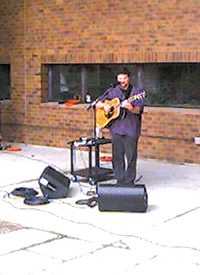Homeless and Hearthless:
April 24, 2002
It is impossible to imagine being homeless, yet thousands live on the streets of Boston every day. We walk pass and turn a blind eye because the problem seems so overwhelming, daunting beyond imagining. Symphony of a City, a cyberart conception came into the Harbor Art Gallery and lingered from April 8-12, rendered in real-time on the Web, telling the stories of the lives of four participants from their perspective over the space of four days.
Conceived by Liz Canner and John Ewing, Symphony of a City was meant as an artistic wake-up call for awareness of the housing and community situation in Boston where, until recently in 1995, there was rent-controlled housing. Two players in this drama are Mike Murray, a UMB student who was homeless and presently lives in a shelter besides attending classes and serving as a member of the UMB Board of Trustees, and John Coppola, owner of several properties throughout Boston and Malden and former president of the Rental Housing Association.
These are the two principle perspectives from which we approach the situation. Coppola’s slant opens with him preparing to leave the sprawling grounds of his opulent home to visit tenants, a sharp contrast to Murray’s beginning drinking coffee and smoking in the parking lot of McDonald’s waiting to meet with a friend who would go and visit various friends of his within the homeless community.
What is striking is not so much as the difference between their lifestyles but the way in which that, through their interaction and dialogue with the viewer an unconscious comparison emerges that may be likened to that of the struggle of “good” versus “evil,” or Coppola versus Murray.
Whether it is intentional or not, Coppola may be labeled, almost comically so, as a villain. In a visit with one of his tenants, where he supposedly shoots the breeze in an effort to detract from the “heartless slumlord,” he asks how things are. The occupant has lived there for over 16 years, and comments on how he is fine and asks when the broken window is going to be fixed, as he has been wondering for the last ten years. He makes a quick, if ignominious, exit, on that note and as he tours his property, we see how dingy the walls are and just how poorly kept it is. He gets into another conversation later on, blaming rising housing costs on government required safety measures (i.e. smoke alarms). His seeming obliviousness to his own faults in overcharging and under-maintaining the tenants and buildings respectively is pathetically humorous in some aspects.
We get to know Murray right off, outside of McDonald’s, as he speaks of battling alcoholism and a divorce that landed him where he was. He is candid, straightforward in describing the realities of homelessness. As he interviews various street dwellers and families struggling to support themselves in the effort to find affordable housing, he comes off as neither self-righteous nor evangelical in his advocacy for the downtrodden, he merely seeks to inform.
I needed to view this documentary twice before I really understood what exactly was going on. It was difficult and somewhat disorienting trying to follow two simultaneous situations, but it was eerie in how their day paralleled to opposing views, occasionally coinciding with one another in the neighboring frames cast upon the walls. The running time was roughly a half-hour, but is more than enough time to get a feel, not only for the personalities, but the struggle that the situation entails. To view Symphony of a City, visit www.Symphonyofacity.org.





















































